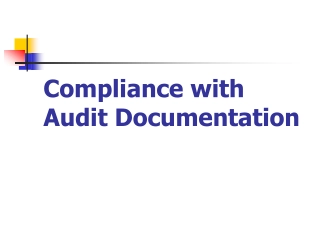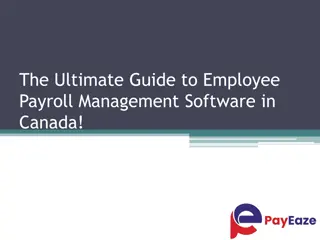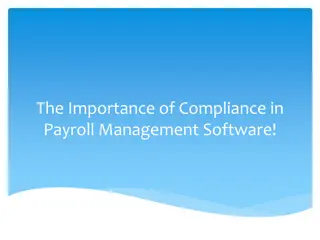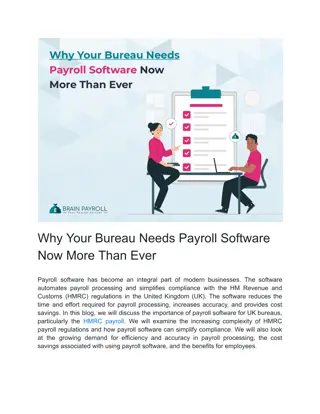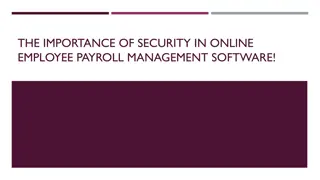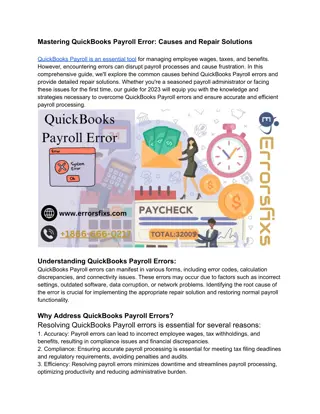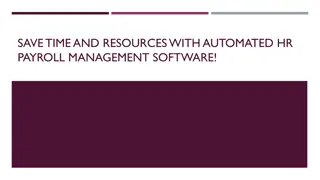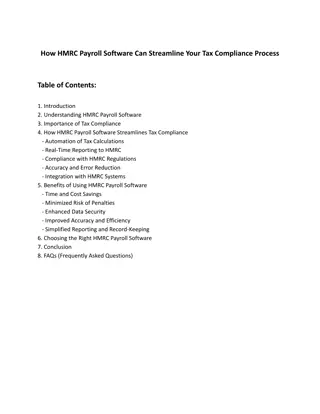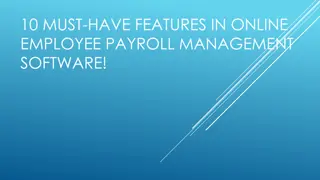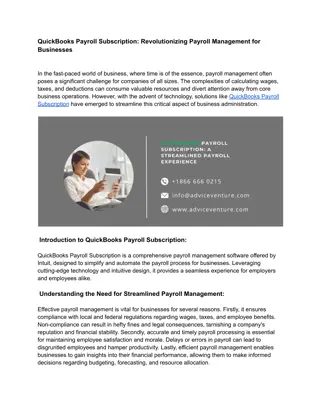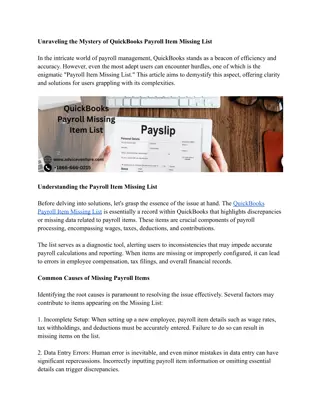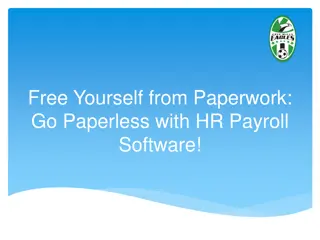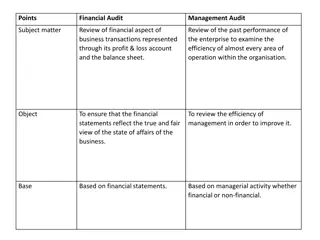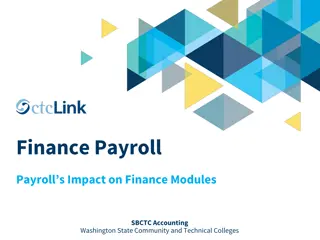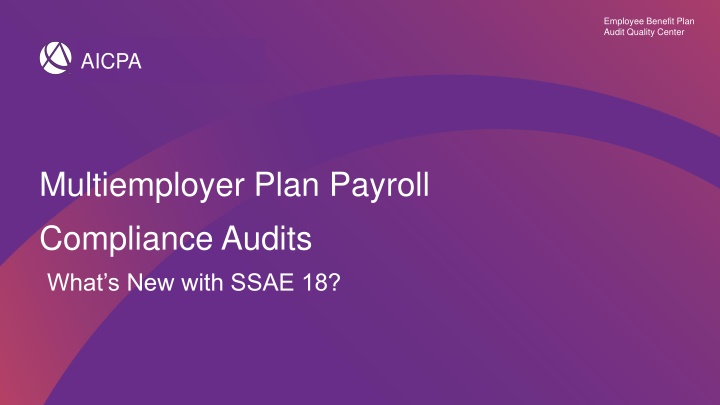
Employee Benefit Plan Audit Quality Center - What's New with SSAE 18?
Explore the latest updates in SSAE 18 and understand the requirements for agreed-upon procedures engagements in the Employee Benefit Plan Audit Quality Center. Get insights on payroll audit processes, red flags, and conducting AUP procedures effectively.
Download Presentation

Please find below an Image/Link to download the presentation.
The content on the website is provided AS IS for your information and personal use only. It may not be sold, licensed, or shared on other websites without obtaining consent from the author. If you encounter any issues during the download, it is possible that the publisher has removed the file from their server.
You are allowed to download the files provided on this website for personal or commercial use, subject to the condition that they are used lawfully. All files are the property of their respective owners.
The content on the website is provided AS IS for your information and personal use only. It may not be sold, licensed, or shared on other websites without obtaining consent from the author.
E N D
Presentation Transcript
Employee Benefit Plan Audit Quality Center AICPA Multiemployer Plan Payroll Compliance Audits What s New with SSAE 18?
Handouts for todays event You can download presentation slides (in PDF or PowerPoint format) and other handouts by clicking on in the toolbar at the bottom of your screen Instructions to how to obtain your CPE certificate for today s event Webinar presentation slides (both .ppt and .pdf formats) TQA 6935.01-.06, Multiemployer Plans EBPAQC Primer, Multiemployer Employee Benefit Plans Summary of EBPAQC Resources and Tools
Presenters Doug Bertossi CliftonLarsonAllen LLP Eileen Brassil Legacy Professionals LLP David Evangelista MBAF CPAs and Advisors, LLC
Introduction and background David Evangelista MBAF Certified Public Accountants and Advisors
Todays webinar Introduction and background Overview of requirements for agreed-upon procedures engagements under SSAE No. 18, Attestation Standards: Clarification and Recodification Who is the engaging party and the responsible party? Requirement to obtain written assertions and written representations Alternative approach as consulting engagement under SSCS No. 1, Consulting Services The role of payroll audits in the financial statement audit process Questions and answers
Overview/background Purpose of payroll audits When payroll audits would not be necessary Red flags Payroll audit cycle/policy Tips for performing payroll audits Questions you should be asking the Plan Trustee Current options for CPAs: AUP vs consulting standards
Performing agreed-upon procedures Doug Bertossi CliftonLarsonAllen LLP
AUP general considerations Need to follow SSAE 18, AT-C Section 215, Agreed-Upon Procedures Engagements SSAE 18 effective for reports dated on or after May 1, 2017 Offers more structure and consistency Independence is not a concern if perform the plan financial statement audit as well
Definitions Engaging party The engaging party is the party that hires the practitioner to provide the service. The engaging party need not be the responsible party. Responsible party The responsible party is someone who takes responsibility for the subject matter. Generally, the responsible party is the management of the entity whose subject matter is being measured.
Significant items with AT-C 215 A written engagement letter is required. Should obtain a written assertion from the responsible parties Should request written representations in the form of a letter, dated as of the AUP report, from the engaging party Should request written representations in the form of a letter, dated as of the AUP report, from the responsible party.
Q&A section 6935, Multiemployer Plans 03, Obtaining engagement letters .04, Requesting and obtaining representation letters from engaging party .05, When representation letters are not received from responsible parties .06, Use of AUP or other reports as audit evidence in a plan audit
Engagement letters Agreed-upon terms of the engagement should be specified in sufficient detail in an engagement letter or other suitable form of written agreement. Received prior to the commencement of the engagement. Q&A 6935 guidance While separate AUP reports are issued for each engagement, all payroll compliance services to be performed may be covered by a single agreement with the plan trustee.
Assertion from responsible parties Assertion is a declaration(s) about whether the subject matter is in accordance with the criteria. Assertion should be provided in writing. Assertion may be acknowledged in a representation letter.
Assertion from responsible parties If the responsible party refuses to provide a written assertion The practitioner should disclose in the written report the contributing employer s refusal to provide If the practitioner is aware prior to obtaining the written engagement letter, in accordance with AT-C 215.16 the engagement letter should make clear that no such assertion will be provided
Representations from engaging party Should request representations from the engaging party in addition to the representations requested from the responsible parties. Representations should be provided in writing. Representation letters should be as of the date of the practitioner s report.
Representations from engaging party What if Engaging Party does not provide a representation letter or it is improperly dated? The practitioner should refer to the guidance in AT-C 215.31, which states that the practitioner should: Discuss the matter with the appropriate party(ies). Reevaluate the integrity of those from whom the representations were requested or received and evaluate the effect, if any, on the engagement, and If any of the matters are not resolved to the practitioner s satisfaction, take appropriate action, which may include: o Withdrawing from the engagement, or o Determining the effect on the practitioner s report
Representations from engaging party Q&A 6935 guidance If representations are the same for each AUP engagement, may request and obtain one representation letter that covers all AUP engagements. Representation letters should be as of the date of the last AUP engagement report pursuant to the engagement letter. Presumes an ongoing dialogue with the engaging party relating to representations prior to the issuance of each AUP report. Practitioner should consider the documentation needed to comply with paragraph .35 of AT-C section 105.
Representations from engaging party Q&A 6935 guidance If unique representations for any specific AUP engagement are present, those representations should be requested and obtained separately from engaging party.
Representations from responsible parties Should request representations from the responsible parties in addition to the representations requested from the engaging party. Representations should be provided in writing. Representation letters should be as of the date of the practitioner s report.
Representations from responsible parties What if a Responsible Party does not provide a representation letter? The practitioner should refer to the guidance in AT-C 215.32, which states that the practitioner should: Make inquiries of the responsible party about, and seek oral responses to, the matters in paragraph .28 If one or more of the requested representations are not provided in writing or orally from the responsible party, the practitioner should take appropriate action, which may include (ref. .A33): o Withdrawing from the engagement, or o Determining the effect on the practitioner s report
Representations from responsible parties What if a Responsible Party does not provide a representation letter? Q&A 6935 guidance Use professional judgment to determine whether the AUP can be performed appropriately. If CBA legally requires the contributing employer to make all relevant payroll records available, it may not be necessary to for the practitioner to request and obtain a representation letter covering the completeness and accuracy of those payroll records.
AUP practical considerations Discuss logistics of obtaining written representation letters with Board of Trustees Consider including legal counsel Educate contributing employers during performance of procedures Provide letters to be signed to engaging party and responsible party with a few days lead time and dictate the date to them Consider application of Q&A Section 6935
Performing consulting engagements Eileen Brassil Legacy Professionals
Consulting engagement Perform under SSCS No. 1, Consulting Services Considered nonattest services If CPA firm performs the plan s financial statement audit, will need to ensure that performing this engagement will not impair auditor independence Does not require a CPA to perform
Independence issues regarding nonattest services (consulting engagement) Need to consider if perform the plan s financial statement audit Ensure that auditor has not accepted any management responsibilities Establish in writing with the Board of Trustees: Objectives of the engagement Services to be performed Client s acceptance of its responsibilities Practitioner s responsibilities Any limitations of the engagement EBPAQC tool, Documentation of Review of AICPA Independence Requirements Where Nonattest Services Are Performed for an EBP Audit Client
Consulting engagements what is different from an AUP engagement Offers more flexibility on procedures and report Do not need to have a written engagement letter Do not need to receive representation letters
Types of payroll audit engagements AUP Consulting SSAE 18, Attestation Standards: Clarification and Recodification AICPA Statements on Standards for Consulting Services As this is an attest service, there would be no concerns for independence in performing the plan audit If performing the plan audit, will need to confirm that firm is independent in regards to the plan audit Need to obtain representation letters from Board of Trustees (engaging party) and, at a minimum, request from contributing employers (responsible party) Not necessary
The role of payroll audits in the financial statement audit process
Use of payroll audits in the plans financial statement audit David Evangelista MBAF CPAs and Advisors, LLC
TQA 6935.06, Multiemployer Plan Payroll Compliance Services- Use of AUP or Other Reports as Audit Evidence Inquiry In a multiemployer plan audit, it is common for the plan auditor to receive payroll testing information from third parties. That information may come from a CPA practitioner who has performed payroll compliance services for multiple participating employers under AT-C section 215. Alternatively, similar payroll service testing information may be performed and received from an internal audit group of the employer. What are the plan auditor s responsibilities and considerations prior to using such information as audit evidence? Reply The plan auditor is responsible for planning and conducting the audit of the plan to obtain reasonable assurance that the plan s financial statements are not materially misstated. As a result, the plan auditor is responsible for designing and performing audit procedures that are appropriate for the purpose of obtaining sufficient appropriate audit evidence. In a multiemployer employee benefit plan, the plan auditor is required to develop audit procedures to test the accuracy and completeness of employer contributions, which may include, but not be limited to, the results of payroll compliance services.
TQA 6935.06, Multiemployer Plan Payroll Compliance Services- Use of AUP or Other Reports as Audit Evidence In accordance with AU-C section 500, Audit Evidence, if information prepared by another practitioner or by management (for example, when payroll is tested by the entity s internal auditor) is to be used as audit evidence by the plan auditor, the plan auditor is required to consider the relevance and reliability of that information. The plan auditor s consideration may include the following: Understanding the competence, capabilities, and objectivity or independence of the person or persons performing the procedures Obtaining an understanding of the work that was performed Evaluating the appropriateness of that information as audit evidence for the relevant assertions Obtaining audit evidence about the accuracy and completeness of the information Evaluating whether the information is sufficiently precise and detailed for the auditor s purpose
Discussion questions How does your firm rely on these payroll compliance audits when testing employer contributions in the plan s financial statement audit? Are your procedures different if the engagement is an agreed-upon procedures or consulting engagement?
CPE Certificate Don t forget to download your CPE certificate! Click on Now!
We welcome your feedback! Please complete the online evaluation

